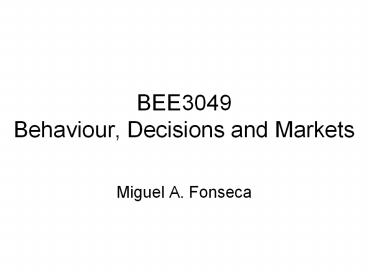BEE3049 Behaviour, Decisions and Markets - PowerPoint PPT Presentation
1 / 18
Title:
BEE3049 Behaviour, Decisions and Markets
Description:
BEE3049 Behaviour, Decisions and Markets Miguel A. Fonseca Recap Last week we set out the basic principles of rational choice. We also looked at deviations from ... – PowerPoint PPT presentation
Number of Views:126
Avg rating:3.0/5.0
Title: BEE3049 Behaviour, Decisions and Markets
1
BEE3049Behaviour, Decisions and Markets
- Miguel A. Fonseca
2
Recap
- Last week we set out the basic principles of
rational choice. - We also looked at deviations from individual
rationality - Inconsistencies with completeness and
transitivity - Ambiguity aversion
- Loss aversion
- Framing effects
3
Recap
- Last week, the focus was on static
decision-making. - Individuals are faced with a one-off decision
based on an information set. - However, a lot decisions are made over time (or
repeatedly) and require the DM to learn about the
environment as the circumstances unfold.
4
An example
- Suppose you have received a blood test result
indicating you have a rare (and fatal) disease. - The incidence of this disease is 0.01
- However, this test is not fully accurate
- If you DO have the disease its 100 accurate
- If you DONT have the disease there is 1 chance
it will come out positive. - How likely are you to have this disease?
5
Conditional probability
- The real probability of having the disease is
actually just over 9!
6
Bayesian probability
- Bayesian probability looks at probability as a
measure of the current state of knowledge. - In other words, probabilities reflect our beliefs
about the state of the world. - So, we should be able to update our beliefs as
new information arises.
7
The Monty Hall problem
- Assume you are in a TV game show. The host
presents you with three doors A, B and C. - Behind one of the doors there is a prize, while
the other two have nothing behind them. - You choose door A Monty then proceeds to open
door C. - Monty then asks whether you would like to switch
doors.
8
Monty Hall
- The Monty Hall problem is an interesting case of
new events NOT adding new information. - Opening an empty door didnt add any new
information about the problem. - As such the underlying probabilities are the same.
9
Charness and Levin (2005)
- Two possible states of the world up or down.
- Twofold task pick an urn draw a ball
- Black ball gives payoff, white ball does not.
- Replace the ball and choose again.
- First draw informs DM about state of the world.
10
Charness and Levin (2005)
- Paper wishes to compare Bayesian Updating (BU)
with a Reinforcement Heuristic (RH) - Treatment conditions
- Better signal
- First draw does not pay out
11
Charness and Levin (2005)
- Drawing from Right urn gives perfect signal about
the state of the world. - Both the BH and RH predict the same outcome.
- Drawing from the Left urn gives an incomplete
signal. - BU agent should switch to Right if draw is Black
- RH predicts the opposite.
12
Charness and Levin (2005)
- Result 1 Switching-error rates are low when BU
and RH are aligned and high with they are not
aligned. - Result 2 Removing affect from initial draw (by
not paying out the outcome) reduces the error
rate, particularly when outcome is positive
(black ball drawn). - Result 4 Taste for consistency. If a subject
initially chose Left Urn, he is less likely to
switch than if initial Left urn draw is imposed.
13
Searching
- An important class of economic decisions requires
DMs to search for the necessary information
before making their decision. - Hiring a new CEO
- Looking for a new job
- Purchasing a new car
- Finding a new supplier.
- Therefore, the act of searching itself has
economic significance.
14
Searching
- Suppose Jane is looking for a job.
- Every time she conducts a search she receives a
wage offer w. - For simplicity assume w is uniformly distributed
between 0 and 90. - Searching implies a cost, c
- Assume for the time being this cost is fixed and
equal to 5. - Whats Janes optimal searching condition?
15
Searching
- Suppose Jane receives an offer w. Should she
accept or continue to search? - She will be indifferent between searching and
stopping if the expected benefit of searching is
equal to the cost of searching, c - E(BoS) (90-w)/90 x (90w)/2 w
- C 5
16
Searching
- Solving (90-w)/90 x (90w)/2 w 5 for w
gives w 60. - Therefore, Jane should accept any offer larger
than 60 and continue to search otherwise.
17
Searching
- Solving (90-w)/90 x (90w)/2 w 5 for w
gives w 60. - Therefore, Jane should accept any offer larger
than 60 and continue to search otherwise. - The more risk averse Jane is, the lower her
reservation wage, w, will be.
18
Searching
- Of course in reality, individuals have imperfect
information about the distribution of wages - This may mean some learning is necessary before a
decision is made. - Another important factor may be a temporal
constraint. Cox and Oaxaca (1989) study search
with a finite horizon. - This means your reservation value will drop the
closer you are to the deadline. - They find that subjects behaviour is consistent
with theory.































